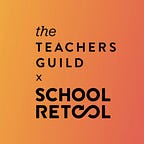Why Sonoma County’s Office of Education Wants to Reimagine Professional Development
Sonoma County’s Deputy Superintendent and Director of Innovation & Partnerships explain.
by Elsa Fridman Randolph
The Teachers Guild sat down with Mickey Porter & Dan Blake of the Sonoma County Office of Education to talk about their Collaboration question: How might we re-imagine professional learning so that we continue to grow, feel inspired, and have the greatest impact on our students? Read on for our interview with Mickey Porter, the Deputy Superintendent, & Dan Blake, Director of Innovation and Partnerships to find out why this question matters to their team and how transforming the traditional approach to professional development could offer students relevance and rigor.
Q: Why is re-imagining professional development for K-12 teachers a compelling need?
A: As an organization our mission is to provide relevant professional development for teachers. If we’re asking teachers to change how they teach in order to meet the 21st century needs of students, we need to be modeling what that might look like in how we instruct adults. We need to be teaching in totally different ways. Just like our students, how adults learn in the 21st c. has totally changed. This “How might we?” question is exceedingly compelling for us because it makes us re-think how all learning in the 21st century has profoundly shifted.
There’s often hypocrisy in how professional development is offered to teachers where we’re telling teachers to do something differently & we’re not modeling how to do it differently ourselves. For us, there’s not a distinction between children and adult learners. It’s learners. It’s all about engagement and piquing intellectual curiosity for all learners. We’re working to engage teacher leaders and to pique their curiosity.
We’ve used the Design Thinking process internally for the last few years in our approach to providing relevant professional development. We use empathy as our starting point. We come at professional development from the viewpoint of “What does the user, the teacher or educator, need who is coming here to learn?” We don’t approach professional development based on what we know or what we can do but instead we use the Design Thinking lens of, “What do students need?” and “What do teachers need to serve students?” Then we find a way to serve those needs. The end user really drives our thinking on professional development.
We believe that the opportunity to host a Collaboration with the Teachers Guild around re-imagining professional development goes hand-in-hand with these cultural shifts we’ve undertaken as a team.
Q: What is an example of a 21st century professional development opportunity for K-12 teachers?
A: In March of 2014, we started to collaborate with Casey Shea, a high school Math teacher from Analy High School in Sebastopol, California. Now he both teaches at Analy High School and works for us part-time. Casey came to our organization to offer a Maker Education professional development experience to a group of pioneering K-12 teachers. We were struck by the energy level, the enthusiasm, the buzz in activity throughout the day & beyond. We received immediate follow-up from teachers telling us how they were implementing their learning in the classroom right away. It was hands-on and learner-centric and involved people in being active participants and not just passive recipients. That was a game changer for us.
Another example that has impacted our thinking is the EdCamp model that believes that the expertise is already in the room because teachers are experts. This philosophy has really impacted how we think about professional development.
Also, the work we’ve partnered with the REEd Center at UC Davis on, the Teacher Based Reform and Integrated Professional Learning Systems work. Teachers participate in a professional development structure that allows them to find their own relevance & engage in making their own meaning but the approach to learning and growth doesn’t have a pre-determined learning outcome for teachers.
Q: How does offering these nontraditional professional development opportunities to K-12 teachers ultimately benefit students?
A teacher needs the learning experience before they can model for students how to think critically and engage in 21st century learning. We can’t expect student behavior to change without adults changing. If adults don’t understand & experience that change for themselves, and rediscover for themselves what it means to be a learner, they can’t offer that to students.
Students need to be at the center of their own learning. Students need to be outside of their comfort zone. Students need to fail and persist through those failures. Teachers need to experience this approach to learning for themselves. The more our professional development can embody these learner-centric, relevant and challenging experiences, the more likely teachers are to be able to bring this approach to learning into their classroom. Telling learners — either teachers or students — is just not enough. We’re shifting to treating teachers as learners and to asking them to experience a 21st century approach to learning as the student. Hopefully, on the other side of the equation, they can better offer engaging learning to their students.
Hear more from teachers about their thoughts on learning and professional development here.
